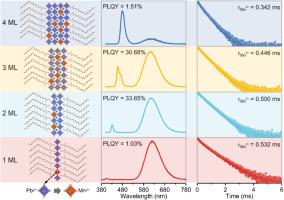Optimizing luminescence in solution-processable 2D perovskite nanoplatelets: The role of Mn2+ doping and layer thickness
IF 5.7
3区 材料科学
Q2 MATERIALS SCIENCE, MULTIDISCIPLINARY
引用次数: 0
Abstract
In this study, ligand-assisted supersaturated recrystallization was employed to synthesize OAm2(CsPbBr3)n-1PbBr4 Two-dimensional (2D) perovskite nanoplatelets (NPLs) with controlled layer thickness (n = 1, 2, 3, and 4), and effective Mn2+ doping was achieved through MnBr2 post-treatment. The Mn2+-doped NPLs (n = 2) show a significant enhancement in photoluminescence quantum yield (PLQY) from 1.85 % (undoped) to 33.7 %. Photoluminescence (PL) lifetime analysis revealed a synergistic mechanism involving defect passivation and exciton-Mn2+ energy transfer. Investigations into the layer-thickness-dependent optical properties revealed that as the n-value increases, the relative intensity ratio of Mn2+ to excitonic luminescence (IMn/Iex) decreased and the Mn2+ PL lifetime shortened. Temperature-dependent PL analysis revealed an anomalous temperature dependence of Mn2+ luminescence in the range of 80–260 K, characterized by thermal enhancement and a single-exponential decay trend with significantly shortened lifetime. Finally, the luminescence regulation mechanisms of layer thickness and Mn2+ doping in 2D perovskite NPLs were elucidated.

优化溶液处理二维钙钛矿纳米片的发光:Mn2+掺杂和层厚的作用
本研究采用配体辅助过饱和再结晶方法合成了OAm2(CsPbBr3)n- 1pbbr4可控层厚(n = 1,2,3和4)的二维(2D)钙钛矿纳米薄片(NPLs),并通过MnBr2后处理实现了Mn2+的有效掺杂。Mn2+掺杂的NPLs (n = 2)的光致发光量子产率(PLQY)从1.85%(未掺杂)显著提高到33.7%。光致发光(PL)寿命分析揭示了缺陷钝化和激子- mn2 +能量转移的协同机制。对层厚度相关光学性质的研究表明,随着n值的增加,Mn2+与激子发光的相对强度比(IMn/Iex)降低,Mn2+ PL寿命缩短。温度依赖性PL分析表明,在80 ~ 260 K范围内,Mn2+的发光表现出异常的温度依赖性,表现为热增强和单指数衰减趋势,寿命明显缩短。最后,研究了二维钙钛矿NPLs中Mn2+掺杂和层厚的发光调控机制。
本文章由计算机程序翻译,如有差异,请以英文原文为准。
求助全文
约1分钟内获得全文
求助全文
来源期刊

Materials Research Bulletin
工程技术-材料科学:综合
CiteScore
9.80
自引率
5.60%
发文量
372
审稿时长
42 days
期刊介绍:
Materials Research Bulletin is an international journal reporting high-impact research on processing-structure-property relationships in functional materials and nanomaterials with interesting electronic, magnetic, optical, thermal, mechanical or catalytic properties. Papers purely on thermodynamics or theoretical calculations (e.g., density functional theory) do not fall within the scope of the journal unless they also demonstrate a clear link to physical properties. Topics covered include functional materials (e.g., dielectrics, pyroelectrics, piezoelectrics, ferroelectrics, relaxors, thermoelectrics, etc.); electrochemistry and solid-state ionics (e.g., photovoltaics, batteries, sensors, and fuel cells); nanomaterials, graphene, and nanocomposites; luminescence and photocatalysis; crystal-structure and defect-structure analysis; novel electronics; non-crystalline solids; flexible electronics; protein-material interactions; and polymeric ion-exchange membranes.
 求助内容:
求助内容: 应助结果提醒方式:
应助结果提醒方式:


